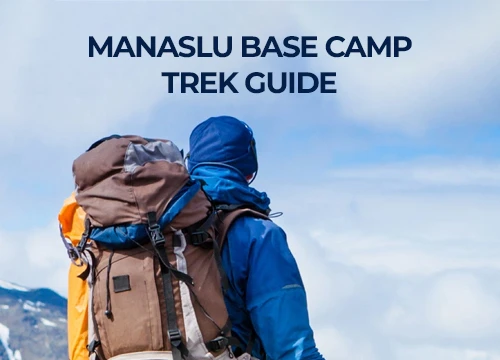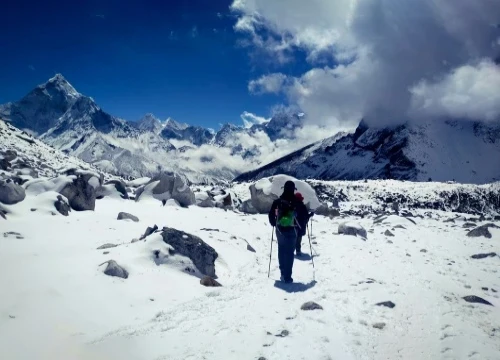Discover the breathtaking beauty of Langtang Valley, a hidden gem nestled in the heart of the Himalayas. Once devastated by the 2015 earthquake, this enchanting valley has been painstakingly rebuilt, offering thrilling tourism experiences for adventure seekers from across the globe.
Langtang valley reconstruction after Earthquake 2015
Table of Contents
Brand Voice: Bold and adventurous
Journey into the Langtang Valley and be captivated by its awe-inspiring landscapes, snow-capped peaks, and vibrant local culture. Immerse yourself in the warmth and hospitality of the Tamang people as you trek through picturesque villages and lush rhododendron forests.
Experience the thrill of crossing suspension bridges suspended high above roaring rivers, and marvel at the panoramic views of majestic Langtang Lirung, Ganesh Himal, and Dorje Lakpa. As you traverse the rugged trails, encounter friendly yaks and maybe even catch a glimpse of elusive wildlife.
The Langtang Valley trek not only offers a thrilling adventure but also provides an opportunity to contribute to the local community's sustainable development. By choosing this trek, you support the rebuilding efforts of the resilient Nepalese people, helping to restore their livelihoods and create a brighter future for generations to come.
Embark on an unforgettable journey to Langtang Valley and witness firsthand the resilience of a community and the indomitable spirit of nature in this unspoiled haven. It’s time to experience the rebirth of Langtang Valley, where thrill awaits at every turn.
The 2015 Earthquake and its impact on the Langtang Valley
The Langtang Valley, nestled in the heart of the Himalayas, was once a thriving hub for trekkers and adventure-seekers. However, in April 2015, the devastating 7.8 magnitude earthquake that struck Nepal had a catastrophic impact on this picturesque region. The quake triggered massive landslides and avalanches, causing widespread destruction and loss of life in the Langtang Valley.
Prior to the earthquake, the Langtang Valley was a popular destination for trekkers, offering breathtaking views of snow-capped peaks, lush forests, and charming Tamang villages. The valley was home to a vibrant community of locals who relied on tourism as their primary source of income. The earthquake, however, dealt a devastating blow to the region, wiping out entire villages and leaving the once-bustling valley in ruins.
The impact of the disaster was truly heartbreaking. Hundreds of lives were lost, and the landscape was transformed beyond recognition. The Langtang National Park, a protected area that was a crucial part of the trekking route, was also severely affected, with many of its trails and infrastructure damaged or destroyed. The Langtang Valley, once a thriving hub for adventure tourism, had been reduced to a shadow of its former self, leaving the local community in a state of despair and uncertainty.
Rebuilding efforts in the Langtang Valley
In the aftermath of the devastating earthquake, the Nepalese government and international aid organizations quickly mobilized to support the rebuilding and recovery efforts in the Langtang Valley. The task ahead was daunting, as the scale of the destruction was truly overwhelming, but the resilience and determination of the local community shone through.
One of the key priorities in the rebuilding process was to restore the infrastructure and trails that were essential for the Langtang Valley trekking route. This involved clearing debris, repairing bridges, and rebuilding damaged lodges and teahouses. The Nepalese government, in collaboration with various non-governmental organizations, worked tirelessly to revive the trekking trails and ensure the safety of visitors.
Alongside the physical reconstruction, the rebuilding efforts also focused on supporting the local community. Many Tamang families had lost their homes, livelihoods, and loved ones in the earthquake, and the task of rebuilding their lives was a daunting one. Aid organizations provided financial assistance, temporary shelter, and skills training to help the community get back on their feet. The goal was not only to restore the Langtang Valley as a tourist destination but also to empower the local people and ensure their long-term well-being.
The Langtang Valley Trekking route and highlights
The Langtang Valley trekking route is a truly remarkable journey that takes adventurers through a breathtaking landscape of snow-capped peaks, lush forests, and charming Tamang villages. The trek typically starts from the town of Syabrubeshi, which is located approximately 120 kilometers north of Kathmandu.
As you embark on the trek, you'll be greeted by the majestic Langtang Lirung, the highest peak in the Langtang region at 7,227 meters. The trail winds its way through the Langtang National Park, where you'll have the chance to spot a variety of wildlife, including the elusive red panda, Himalayan black bear, and the Himalayan tahr.
One of the highlights of the Langtang Valley trek is the opportunity to immerse yourself in the rich cultural heritage of the Tamang people. These resilient and welcoming communities have a deep connection to the land, and you'll have the chance to learn about their traditions, customs, and way of life. Along the way, you'll encounter charming villages, where you can visit local monasteries, sample traditional Tamang cuisine, and interact with the friendly locals.
Permits and logistics for Langtang Valley Trekking
Trekking in the Langtang Valley requires obtaining the necessary permits and navigating the logistics of the journey. The first step is to obtain a Trekking Information Management System (TIMS) card, which is a mandatory permit for all trekkers in Nepal. This card can be obtained from the Nepal Tourism Board or authorized trekking agencies.
In addition to the TIMS card, you'll also need to obtain a Langtang National Park permit, which is required to enter the protected area. This permit can be obtained at the park entrance or through your trekking agency. It's important to note that the permits must be obtained before the start of your trek, as they cannot be purchased along the way.
Arranging transportation to the starting point of the trek, Syabru Besi, is another important logistical consideration. Many trekkers choose to take a bus or private vehicle from Kathmandu, which takes approximately 5-6 hours. Alternatively, you can arrange a private transfer or join a group tour, which can provide a more comfortable and hassle-free experience.
The best time to visit Langtang Valley
The best time to visit the Langtang Valley for trekking is during the spring (March to May) and autumn (September to November) seasons. These periods offer the most favorable weather conditions, with clear skies, moderate temperatures, and minimal rainfall.
During the spring season, the Langtang Valley is ablaze with vibrant wildflowers, including the stunning rhododendrons that carpet the hillsides. The air is crisp and cool, making it an ideal time for trekking. The autumn season, on the other hand, offers exceptional mountain views, as the skies are typically clear and the temperatures are comfortable.
It's worth noting that the winter months (December to February) can be quite cold and snowy, making the trek more challenging. The summer months (June to August) are also not recommended, as the region experiences heavy monsoon rains, which can make the trails muddy and increase the risk of landslides.
Accommodation and facilities in the Langtang Valley
As the Langtang Valley trekking route has been rebuilt and revived, the accommodation and facilities available to trekkers have also improved significantly. Along the trail, you'll find a network of lodges and teahouses that cater to the needs of adventurous travelers.
These lodges and teahouses, often run by the local Tamang communities, offer basic but comfortable accommodations, with shared dormitory-style rooms and communal dining areas. The food served is typically a mix of traditional Nepali and Tibetan-influenced cuisine, with staples like dal, rice, and vegetable curries. While the facilities may not be luxurious, they provide a warm and welcoming environment for weary trekkers.
In the larger villages, such as Langtang and Kyanjin Gompa, you'll find more modern and well-equipped lodges that offer private rooms, hot showers, and even Wi-Fi. These higher-end accommodations cater to those seeking a more comfortable trekking experience. It's important to note that the availability and quality of facilities can vary, and it's always a good idea to book your accommodations in advance, especially during the peak trekking seasons.
Safety precautions and challenges during Langtang Valley Trekking
Trekking in the Langtang Valley, while an incredibly rewarding experience, does come with its fair share of challenges and safety considerations. The rugged terrain, high altitudes, and unpredictable weather conditions can pose risks to trekkers, and it's essential to be well-prepared and take the necessary precautions.
One of the primary concerns is the risk of altitude sickness, which can occur at the higher elevations of the trek. Proper acclimatization, staying hydrated, and being aware of the symptoms are crucial to preventing and managing altitude-related issues. Trekkers should also be prepared for sudden changes in weather, as the Himalayas can experience rapid temperature drops, snowfall, and heavy rainfall.
The trails in the Langtang Valley can also be challenging, with steep ascents, slippery surfaces, and the occasional suspension bridge crossing. It's important to have the right gear, including sturdy hiking boots, trekking poles, and warm clothing, to navigate these obstacles safely. Additionally, trekkers should be mindful of their physical fitness and pace themselves accordingly, as the high-altitude environment can be physically demanding.
Guided tours and trekking agencies in the Langtang Valley
For those who prefer a more guided and supported trekking experience, there are numerous reputable trekking agencies and tour operators that offer organized tours to the Langtang Valley. Planner Planner Nepal can handle all the logistics, from obtaining the necessary permits to arranging transportation and accommodations.
Guided tours can be particularly beneficial for first-time trekkers or those who are unsure of the route and the challenges they may face. The guides employed by these agencies are typically experienced and knowledgeable about the local terrain, culture, and wildlife, and they can provide valuable insights and support throughout the trek.
When choosing a trekking agency, it's important to do your research and select a reputable operator with a proven track record of providing safe and enjoyable experiences. Trekking agencies are licensed, insured, and have a strong commitment to sustainable tourism practices. Additionally, consider the size of the group, the level of support provided, and the overall itinerary to ensure that it aligns with your preferences and expectations.
Conclusion: Langtang Valley Trekking is a unique and meaningful adventure experience
The Langtang Valley, once devastated by the 2015 earthquake, has risen from the ashes, offering a truly unique and meaningful adventure experience for trekkers and nature enthusiasts. This resilient and captivating region of the Himalayas invites you to embark on a journey that not only immerses you in breathtaking landscapes but also connects you with the vibrant Tamang culture and the local community's inspiring story of rebuilding.
By choosing to trek in the Langtang Valley, you not only get to witness the indomitable spirit of nature and the human spirit but also contribute to the sustainable development of the region. Your trek will support the local economy, empower the community, and help preserve the natural and cultural heritage of this remarkable destination.
So, pack your bags, lace up your hiking boots, and get ready to embark on an unforgettable adventure in the Langtang Valley. Witness the rebirth of this once-devastated region and be a part of its inspiring journey toward a brighter future. The thrill and the meaning of this trek will stay with you long after you've returned home, leaving an indelible mark on your heart and soul.







